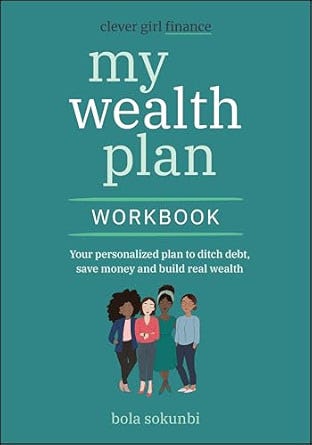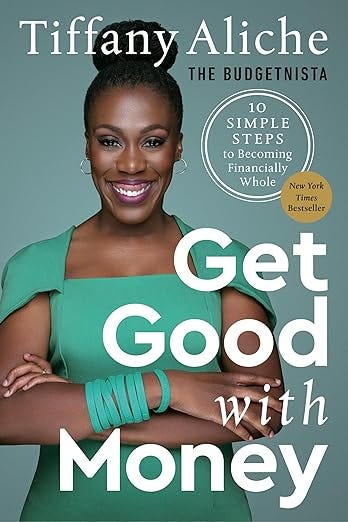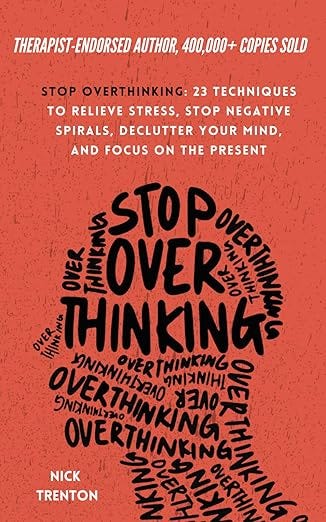Should You Be Worried About Stagflation?
📝 What it is and how to prepare if the economy takes a turn
Here’s what to expect in this newsletter!
(P.S. If this newsletter is cut off in your email just visit our Substack!)
📰 Interesting financial news: Stay up to date on what’s happening in the economy.
📈 What’s popping in the stock market: The 411 on trending/interesting stock market news.
📝 This week’s main topic: What this newsletter’s title is about!
🥰 Team CGF’s Amazon favs: Affordable yet helpful Amazon finds.
📰 Interesting financial news
Student loan borrowers in default could see up to 15% of Social Security benefits garnished. (NBC)
Is it finally a buyer's housing market? What to know about home prices, rate
”lock-in”. (USA Today)How to avoid credit card late fees after a court threw out a proposed cap. (AP)
📈 What’s popping in the stock market
Foot Locker stock skyrockets on report of buyout by Dick’s Sporting Goods. (Ticker Symbols: FL, DKS)
Wingstop shares climbed after positive responses to it’s new AI powered “smart kitchen” rollout. (Ticker Symbol: WING)
American Eagle stock plummets on weak results. (Ticker Symbol: AEO)
📝 Main topic: Is the US headed for stagflation?
The U.S. hasn’t experienced stagflation since the 1970s. Other than a close call in 2022, the economy hasn’t slowed to stagflation levels. Yet, this economic downturn may be on the horizon.
This uncertainty has left many people nervous about the future. While stockpiling food and selling stocks might feel like the right thing to do, you don’t have to resort to desperate measures.
That said, let’s talk about what stagflation is and how you can prepare.
What Is Stagflation?
Stagflation is mainly defined as a period of persistent slow economic growth, combined with high inflation, and high unemployment.
A blend of the words "stagnation" and "inflation," the term was popularized by British politician Iain Macleod in the 1960s, during a time of economic turmoil in the United Kingdom.
While the U.S. isn’t currently experiencing stagflation, there are signs that we might be heading in that direction.
A recent economic report led the Atlanta Federal Reserve to lower its estimate for how much the U.S. economy will grow in the first quarter. Now, they expect the economy to shrink by 2.8%.
If this happens, it would be the first time growth has gone negative since early 2022 and the biggest drop since the COVID-19 lockdown in 2020.
Uncertainty can lead to a weak economy
One of the main reasons the economy is looking shaky is due to uncertainty around tariffs. Higher tariffs can increase the price of goods that rely on foreign materials. In turn, higher prices can reduce consumer spending.
Additionally, trouble is stirring in other areas, with unemployment at 4.2%.
There isn’t much positive news surrounding the economy right now. And with uncertainty, many people become reactive—by rushing to buy or sell, or by hoarding their money.
Although the fear of what’s to come is real, it shouldn’t dictate your financial decisions.
Let’s break down what you can do today to help prepare for an uncertain future.
How to Prepare for Stagflation
As you read through these steps, try not to overwhelm yourself. Take things one step at a time. Remember, slow and steady progress is better than rushing in and making mistakes.
1. Understand your financial situation
Do you know how much you make every month? Do you have enough to cover your monthly expenses, or do you feel like you’re putting out fires all the time?
Most importantly, does your salary cover your basic needs? Take time to review your income, expenses, and spending.
Are you making enough to get by? Are there any money leaks in your budget? Are you relying too much on credit cards?
If you find that you’re financially secure, great job—give yourself a pat on the back. If things are difficult or you’ve made some mistakes, remember not to judge yourself. Identify your areas for improvement and make a plan to do better.
2. Avoid panic buying
A scarcity mindset often kicks in during emergencies or periods of uncertainty. It’s normal to start purchasing things like cars, clothes, or electronics out of fear that prices will rise.
But before you start swiping your card, consider whether you’re buying out of fear or preparation.
Buying things you’ll genuinely need in the future is one thing. Making purchases because you fear missing out can hurt you financially.
Instead, stick to your budget. If there’s something you need, see what adjustments you can make in your budget to afford it.
Here are some things to consider before you start purchasing new items.
Electronics
Before buying new electronics, try clearing up memory first. When my computer runs slow, I panic and think about buying a new one. Then I delete unused files or move them to an external hard drive, and things usually improve.
Car parts
With many car parts manufactured abroad, prices may rise. Regular maintenance and tune-ups can help reduce the likelihood of needing costly repairs.

3. Focus on living below your means
Living below your means isn't just about having less. It’s about increasing the gap between your income and expenses. You can either increase your income without increasing expenses or maintain your income and reduce expenses.
For example, if you earn $2,000 a month and your expenses are $1,900, cutting costs to $1,700 gives you $300 to save or pay off debt.
If you live in a two-income household, consider trying to live on one salary if possible and saving the other.
4. Build an emergency fund
If you’ve been a part of our community for a while you know how important an emergency fund is.
Having extra cash on hand can help during pet emergencies, dental issues, or reduced work hours.
The general recommendation is to save three to six months’ worth of basic living expenses, if you can save more during times like this - great . If that feels overwhelming, start by saving $1,000 and build from there.
Tips to jump-start your emergency fund:
Calculate how much you need (start with three months of essentials).
Build savings into your budget.
Cut unnecessary expenses.
5. Pay off high-interest debt
When I started accumulating debt, I thought paying the minimum was enough.
After a while, it felt like I was flushing money down the toilet. Every month I’d pay my bill, only to see my balance go down by $5. It was frustrating.
High interest was the strong current pulling me away from financial freedom. I was putting in a lot of energy, aka money, but not making progress.
To live a debt free life, I had to shift my thinking. I was paying $400 a month on credit cards. Then I asked myself: What could I do with an extra $400 a month? I thought about places I could travel. I considered how I could help friends and family.
These answers became my motivation for making a debt repayment plan. Here's how to start your plan.
Pick a time and a place to make your plan
Pick a day this week to sit down and review your debt. Play some feel-good music, grab your favorite drink, and take a look at the total.
I hated this part, but I decided to let that number motivate me instead of shame me.
Choose your strategy
Focus on one debt at a time. You can either start with the highest-interest debt (to save money) or the smallest (for a quick win).
Use a debt calculator to decide how much to pay each month to meet your goal.
Make it easy
Set up automatic payments so you never miss one. Track your progress and celebrate small wins along the way.
And remember: Don’t add more debt. Paying off debt while still creating more is like running a marathon in high heels—you might make some progress, but you’ll likely do more damage than good.
6. Diversify your investments
With market volatility, it’s natural to feel uncertain about investments. Your anxiety might tell you to sell, sell, sell. But if you can quiet that anxiety, focus on diversification.
A well-diversified portfolio usually includes stocks, bonds (or other fixed-income assets), and cash. This mix helps you weather market fluctuations.
Ways to diversify your investments:
Invest in different sectors: Spread stock investments across industries like consumer goods, healthcare, energy, and tech.
Use index or mutual funds: These offer built-in diversification by pooling your money with other investors.
Hold cash or cash vehicles These offer stability and liquidity.
Explore international markets: This reduces reliance on one economy and opens up new growth opportunities.
By diversifying, you aren’t putting all your eggs in one basket. You’re building a financial safety net.
7. Educate yourself
As the saying goes, knowledge is power. When it comes to finances, it’s also your key to long-term stability.
Staying informed about the economy helps you make better decisions. Read articles, listen to financial podcasts, watch videos, or take courses (ours are free!). The more you know, the more confident you’ll feel.
Financial education is like a lifelong friend. The more you learn, the more empowered you become.
8. Start a side hustle
Do you have a skill or passion people compliment you on? You might be able to turn it into extra income. Likewise consider taking on work with a recession-proof job.
Here are a few ideas:
Pet care or pet sitting
Accounting or bookkeeping
Cleaning services
Child care
Having extra income streams helps you weather any economic storm.
Although we can’t control the economy’s direction, we can always take control of our money. You can get ahead of the game with our free course bundle on investing. Learn about how the stock market works so you can protect yourself in the future.
🥰 Team CGF’s Amazon Favs
The best way to avoid financial pitfalls is to stay organized and taking care of yourself. Changes in the economy affect our money and emotions as well. Here are some ways to take care of your finances and mental health.
P.S. If you make a purchase we may earn a commission, this helps us grow!
Clever Girl Finance My Wealth Plan Workbook: Your Personalized Plan to Ditch Debt, Save Money, and Build Real Wealth

Getting organized with your finances can be overwhelming. Do you start with a budget, organize financial documents, or work on your mindset?
If you are feeling paralyzed about how to start your financial journey, then the Clever Girl Finance My Wealth Plan Workbook is for you. Make a plan to organize your finances and create financial security and wealth.
This workbook is filled with information on all aspects of finances, such as building a budget, creating a debt repayment plan, understanding investing, and ideas for a side hustle. Filled with worksheets and questionnaires, you’ll have a step-by-step plan on how to reach financial security.
Grab your copy to have on hand when you start to feel anxious about the current state of the economy. When money stress starts to build up you can grab your workbook off the shelf, get to work, and remind yourself to stay the course.
Your Journey to Financial Freedom: A Step-by-Step Guide to Achieving Wealth and Happiness

Do you often feel like you’re playing an emotional game of tennis between saving money and treating yourself? Our adult brain tells us we must save because it’s the responsible thing to do. Yet our inner child is whispering to buy that new dress that will make us feel pretty and confident.
Well, according to podcaster Jamila Souffrant, you can save and spend responsibly. In her book, Your Journey to Financial Freedom, she guides you to identify your current financial "Journeyer" stage and tailor your spending and saving goals accordingly. S
She also helps you envision and plan for scenarios like early retirement and financial independence. Plus, you’ll discover unexpected ways to reduce daily expenses while prioritizing joyful spending and develop a personalized, effective debt-elimination strategy.
Drawing on her experiences as a wife, mother of three, and first-generation Jamaican immigrant, Jamila intimately understands the balancing act of saving for the future while living fully in the present.
Get Good with Money: Ten Simple Steps to Becoming Financially Whole

If one person knows what it’s like to navigate a financial crisis, it’s Tiffany Aliche, once a thriving pre-school teacher with comfortable savings. Yet, when the recession hit, she experienced a devastating financial setback. This personal crisis ignited her journey to financial recovery, leading to the creation of her powerful ten-step formula for achieving both financial security and inner peace, which she has included in Get Good with Money.
Her book develops into the transformative concept of financial wholeness with actionable checklists, insightful worksheets, and a valuable resource toolkit. Some of the most impactful features of her book include:
A straightforward method to define your essential "noodle budget," analyze and organize your spending, and create a plan that allows you to pursue your aspirations.
An assessment tool to pinpoint whether you're facing an income deficit or overspending, along with effective strategies to address both.
Proven best practices for building emergency savings (for unexpected events like job loss), saving for significant purchases (homes, travel, vehicles), and investing for a secure future.
Get Good with Money is an indispensable guide to developing sound financial habits and making your money work for you. The knowledge in this book will ultimately help you build a rich and resilient foundation for your life and legacy.
Stop Overthinking: 23 Techniques to Relieve Stress, Stop Negative Spirals, Declutter Your Mind, and Focus on the Present (The Path to Calm)

One of the reasons you may be stressed over money is because you’re overthinking. Maybe you’re telling yourself you’re not good with money because of your past mistakes. Perhaps a news clip of plummeting stocks is on repeat in your head. If your head is not in a good place, it can be hard to dig yourself out of a hole of negative thoughts. Fortunately, there’s help.
Nick Trenton's Stop Overthinking understands the mental traps that lead to anxiety and unhappiness. This book offers a compassionate and practical guide to rewiring your brain and controlling your thoughts. Through detailed, proven techniques and scientific approaches, you'll learn to break free from negative thought patterns and cultivate a more present and worry-free existence.
Say goodbye to self-deprecating thoughts and sleepless nights. Free your mind from the burden of overthinking and open yourself up to achieving more, feeling better, and fully experiencing the present moment.






